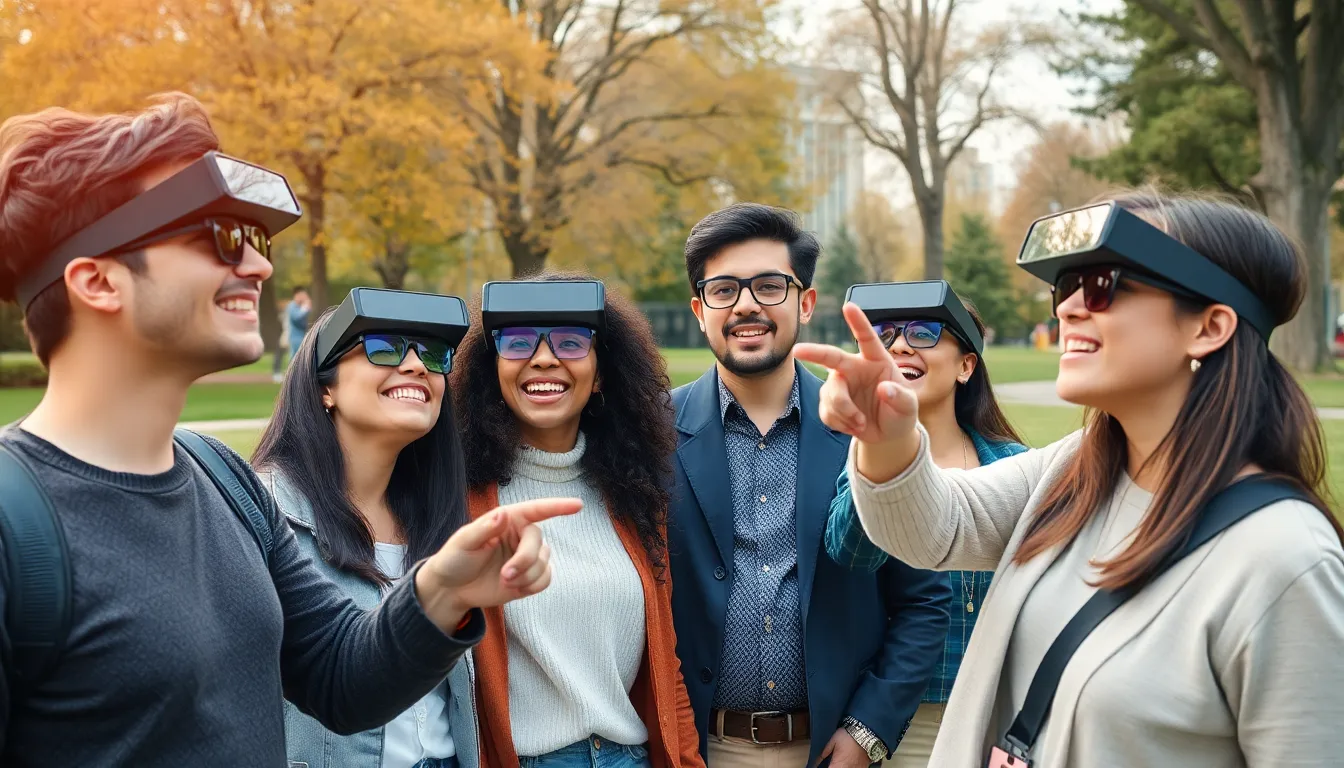In a world where reality sometimes feels a bit too mundane, augmented reality game development swoops in like a superhero, transforming everyday experiences into thrilling adventures. Imagine wandering through your local park only to find a dragon lurking behind a tree or a treasure chest hidden under a bench. This isn’t just a daydream; it’s the magic of augmented reality, where the lines between the virtual and the real blur in the most exciting ways.
As developers dive into this innovative realm, they’re not just coding; they’re crafting experiences that captivate players and spark their imaginations. With tools and technologies evolving faster than a speeding bullet, the potential for creating engaging and immersive games is limitless. So, whether you’re a seasoned developer or just curious about the possibilities, it’s time to explore the thrilling world of augmented reality game development and unleash creativity like never before.
Table of Contents
ToggleOverview of Augmented Reality Game Development
Augmented reality game development creates unique experiences by blending digital elements with real-world environments. Developers harness innovative technologies to enhance gameplay, allowing players to interact with virtual items seamlessly integrated into their surroundings. Platforms such as ARKit and ARCore offer robust frameworks for creating immersive applications, enabling developers to bring fantastical elements to life.
Game mechanics featuring location-based interactions play a crucial role in engaging players. Using GPS technology, developers can design experiences that depend on a player’s physical location, turning familiar spaces into dynamic game worlds. Notable examples like Pokémon GO demonstrate this concept effectively, captivating users worldwide.
Designing user interfaces in augmented reality requires a different approach. Direct manipulation and intuitive gestures improve interaction quality, allowing users to engage with both virtual and real aspects simultaneously. Incorporating feedback loops enhances player immersion by responding to actions, creating a more interactive experience.
Testing remains vital in the development process. Balancing performance across various devices ensures a consistent experience. Performance metrics guide developers in optimizing graphics and responsiveness, which significantly impacts user satisfaction.
Emerging trends shape the future of augmented reality game development. Artificial intelligence integration will likely advance gameplay dynamics, while enhanced visual fidelity captivates players’ attention. As new technologies evolve, augmented reality gaming becomes increasingly accessible, inspiring developers to push creative boundaries.
Key Technologies in Augmented Reality Gaming

Augmented reality gaming relies on various technologies to create immersive experiences. Key components include computer vision and sensor tracking, which enhance the interaction between digital elements and the real world.
Computer Vision
Computer vision plays a crucial role in AR applications by enabling devices to understand and interpret the physical environment. It identifies surfaces, detects objects, and recognizes patterns through image processing algorithms. This technology allows developers to overlay digital objects onto physical spaces accurately. By interpreting visual data, computer vision ensures that virtual elements respond seamlessly to real-world movements. Dynamic lighting and shadow effects enhance realism, providing players with engaging interactions. The precision of computer vision significantly influences user experience in augmented reality games.
Sensor Tracking
Sensor tracking entails using multiple sensors to detect player movements and environmental changes accurately. Devices employ accelerometers, gyroscopes, and GPS to gather spatial data, which informs the positioning and orientation of virtual elements. This capability enables developers to create location-based interactions that feel natural and responsive. Sensors track head movements, hand gestures, and device position, ensuring that players engage with the game intuitively. High-quality sensor tracking minimizes latency and fosters a more authentic experience. Developers can create complex gameplay mechanics by leveraging these tracking technologies effectively.
Game Design Principles for Augmented Reality
Successful augmented reality game design emphasizes innovative user experiences and engaging gameplay elements. Developers create environments where players interact seamlessly with digital and physical worlds, enhancing the overall immersion.
User Experience Considerations
User experience stands at the forefront of AR game design. Developers prioritize intuitive interfaces, ensuring players can navigate digital elements effortlessly. Clear visual cues guide interaction, while context-rich notifications keep players informed. Effective usability testing uncovers potential challenges, refining engagement strategies. Consequently, focusing on comfort and accessibility enhances player satisfaction and retention.
Interactive Elements in Gameplay
Interactive elements significantly elevate gameplay in augmented reality. Developers integrate touch, voice recognition, and motion sensors to foster natural interactions. Vibrant visuals coupled with sound effects create a dynamic atmosphere, enriching player experiences. Location-based interactions anchor gameplay in real-world contexts, promoting exploration and discovery. Players engage deeply when the environment actively responds to their actions, making the experience feel alive and immersive.
Tools and Platforms for Development
Numerous tools and platforms facilitate the development of augmented reality games. These technologies empower developers to create engaging, immersive experiences.
Popular Game Engines
Unity stands out as a leading choice for AR game development. It’s known for its flexibility and user-friendly interface, making it accessible for both novices and experienced developers. Unreal Engine provides high-end graphics capabilities, enhancing visual fidelity in AR applications. Both engines support cross-platform development, allowing creators to reach wider audiences. Cocos2d offers a lightweight alternative focused on 2D game development, suitable for simpler AR experiences. Furthermore, Godot has gained traction due to its open-source nature, appealing to developers seeking customizable solutions.
AR Development Frameworks
ARKit serves as Apple’s framework, delivering powerful tools tailored for iOS devices. It equips developers with features like face tracking and environment mapping to enrich gameplay. Google’s ARCore is designed for Android devices, offering similar capabilities that enable the creation of realistic AR interactions. Vuforia provides another versatile option, supporting a range of devices and offering advanced features such as image recognition. Spark AR stands out for its focus on social media integration, allowing for seamless deployment of AR experiences on platforms like Instagram and Facebook. Each framework grants unique features catering to different project needs, guiding developers in selecting the right tools for their goals.
Challenges in Augmented Reality Game Development
Augmented reality game development presents unique challenges that developers encounter. One significant issue lies in the technical limitations of devices. Device performance varies, making it crucial for developers to optimize games for multiple platforms. Creating games that deliver a consistent experience across different hardware requires careful planning and testing.
Another challenge involves the complexity of environmental interaction. Accurate overlay of digital objects on physical surfaces demands precise sensor tracking and advanced computer vision. Without these technologies, the immersive experience suffers, leading to player frustration.
User interface design presents further hurdles. Developers must create intuitive interfaces that accommodate various interaction methods, including touch and gesture recognition. A lack of clear visual cues can confuse users, diminishing engagement and enjoyment of the game.
Moreover, ensuring seamless gameplay adds to the obstacles in AR development. Latency issues can disrupt the real-time interaction between players and digital elements. Minimizing delays contributes significantly to creating a fluid and engaging experience that captivates users.
Catering to diverse audiences creates additional complexity. Different age groups and experience levels interact with games in varying ways. Developers benefit from understanding these demographics to design more inclusive gameplay.
Lastly, market competition increases pressure on developers to innovate continuously. Standing out in a crowded marketplace requires unique concepts and high-quality execution. Balancing creativity and technical feasibility becomes essential for success in AR game development.
Future Trends in Augmented Reality Gaming
Augmented reality gaming continues evolving with exciting trends shaping its future. Enhanced artificial intelligence is poised to create more responsive and adaptive gameplay experiences. Players may encounter dynamic environments that react intelligently to their behaviors and preferences.
Integration of mixed reality experiences becomes increasingly prominent. This approach combines both virtual and augmented reality, offering immersive and interactive gameplay. Developers can create unique scenarios where digital elements blend seamlessly with the real world, enhancing player engagement.
Improved hardware capabilities drive advancements in AR gaming. Next-generation mobile devices equipped with powerful processors and advanced sensors support more complex graphics and gameplay mechanics. New features, like eye tracking and advanced haptics, further enrich user interactions.
The rise of social AR gaming encourages collaborative experiences. Players engage in real-time activities with friends, transforming familiar spaces into shared gaming arenas. This trend fosters community-building and enhances the social aspects of gaming.
Emphasis on location-based experiences gains traction. Games that utilize geographic data allow developers to craft personalized adventures tailored to specific locales. By transforming everyday environments into dynamic game worlds, players develop deeper connections to their surroundings.
Investment in cross-platform development becomes crucial. As multiple platforms adapt to AR technology, creators focus on ensuring consistent experiences across devices. This strategy allows wider reach, attracting diverse audiences interested in AR gaming.
Adapting to evolving player expectations emerges as a necessity. Developers must prioritize user-friendly interfaces and intuitive designs. By creating systems that facilitate easy navigation and interaction, they enhance overall satisfaction and encourage engagement.
Augmented reality game development stands at the forefront of innovation in the gaming industry. As developers harness the power of cutting-edge technologies and creative design principles, the potential for immersive experiences continues to expand. The integration of AI and improved hardware will further enhance gameplay, making it more responsive and engaging.
Embracing the challenges and opportunities in AR will allow developers to create captivating worlds where players can explore and interact in ways never seen before. With the right tools and a focus on user experience, the future of AR gaming promises to be exciting and transformative. The journey into augmented reality is just beginning, and the possibilities are endless.


